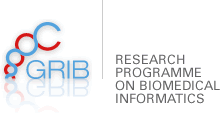Tuesday, 27th March, 2012, 15:00
The origin of new genes
Speaker: Diethard Tautz, Max-Planck Institut für Evolutionsbiologie, Plön, Germany
Room Xipre (seminar 173.06-183.01)
Thursday, 22th March, 2012, 11:00
How do antimicrobial peptides really work? Adventures in NMR of whole bacteria
The mechanisms that antimicrobial peptides (AMPs) use to disrupt membranes have been studied extensively using NMR and other
biophysical techniques. However, such studies have generally been limited to model lipid systems. In real life, antimicrobial peptides interact with a much more complex environment that includes membrane proteins, a peptidoglycan layer, lipopolysaccharide, lipid domains, etc. One way to illustrate the impact of this complexity is to consider the difference in peptide:lipid molar (P:L) ratios between the conditions under which the biological activity of AMPs is observed and the conditions under which NMR studies of mechanism are conducted. Solid-state NMR and other biophysical studies of model systems can typically show AMP-induced changes at peptide:lipid ratios close to 1:100. Strikingly, however, a ratio of 100 bacterially bound peptides per lipid is needed to see inhibition in an Escherichia coli sterilization assay, i.e., 10000 times more peptide per lipid. In order to bridge this enormous gap, we have designed a procedure to incorporate high levels of 2H NMR labels specifically into the cell membrane of Escherichia coli and used this approach to study the interactions between the AMP MSI-78 and the membranes of intact bacteria. I will present the highlights from these whole-cell studies along with results from solution NMR structural studies, as well as molecular dynamics simulations starting from unassembled bilayers.
Speaker: Valerie Booth- Department of Biochemistry and Department of Physics and Physical Oceanography, Memorial University of Newfoundland, Canada
Room Xipre (seminar 173.06-183.01)
Sunday, 18th March, 2012
Integrative computational strategies addressing drug safety issues: the EU-ADR and eTOX projects
AMIA, San Francisco, 19-23 March 2012
Speaker: Sanz F
Thursday, 8th March, 2012, Friday, March 9th 2012; 11:00-12:00,
May the force be with you: Biomolecular Nanomachines and the Dynasome
Speaker: Helmut Grübmuller, Max-Planck Institute, Goettingen, Germany
Room Xipre (seminar 173.06-183.01)
Wednesday, 7th March, 2012, 11:00
Structure and age jointly influence rates of protein evolution
Speaker: Macarena Toll - Biomedical Informatics, GRIB (IMIM - UPF)
Room Aula
Thursday, 1st March, 2012, 11:00 - 12:00
Structure-based drug design: Towards accurate predictions of thermodynamic and kinetic parameters
Speaker: XAVIER BARRIL - Universitat Barcelona
Room Seminar Room “Xipre” 173.06 (PRBB 1st floor)
Wednesday, 29th February, 2012, 11:00
Troublemakers in cancer: a tale of usual suspects and novel villains
The expansion of the catalogs of somatic alterations in cancer accelerate as new laboratories release the sequences of cohorts of samples of different tumor types. One of the key challenges posed by this growth is the identification of driver alterations, genes and pathways among all the alterations found in several patients with the same disease. Traditionally, likely driver mutations for instance are identified either by their recurrence or by their impact on protein function. On the other hand, genes and pathways are prioritized according to the recurrence of alterations that they bear in such groups of samples, however this approach have some known limitations. We have developed an approach to improve the capability of known tools to assess the functional impact of somatic mutations, based on correcting their scores by the baseline tolerance of their bearing proteins. Also, we have developed a method to uncover cancer drivers based on the detection of the bias towards the accumulation of variants with high functional impact across several tumor samples. We present the results of applying this method to several cancer datasets and show that very different pathways to tumorigenesis prevail in each of them.
Speaker: Abel Gonzalez-Perez - Biomedical Informatics, UPF
Room Aula
Wednesday, 8th February, 2012, 11:00
Development and analysis of a chordate and plant orthologous promoter database
Speaker: Endre Sebestyen. Regulatory Genomics Group- GRIB
Room Aula
Thursday, 19th January, 2012, 11:00-12:00,
Template Based Protein-Protein Interaction Prediction and Towards Structural Interactomes
Protein–protein interaction networks provide valuable information in understanding of cellular functions and biological processes. Recent advances in high-throughput techniques have resulted in large amount of data on protein-protein interactions and lead to construction of large protein-protein interaction networks. However, these networks lack structural (3D) details of most interactions, and these structural details are the key components usually for understanding the function of proteins. Therefore, integrating structural information into protein networks on the proteome scale is important because it allows prediction of protein function, helps drug discovery and takes steps toward genome-wide structural systems biology. In this talk, a fast method for structural modeling of protein-protein interactions that combines template-interface-based docking with flexible refinement will be presented. Its application towards building structural protein-interaction networks will be discussed with the examples on p53 interactions and E2-E3 interactions. In addition, how the structural networks can help drug discovery along the line of emerging polypharmacology paradigm will be discussed.
Speaker: Prof. ATTILA GURSOY, College of Engineering, Koc University, Istanbul, Turkey
Room Seminar Room “Xipre” 173.06 (PRBB – 1st floor)
Wednesday, 18th January, 2012, 11:00
Evolutionary dynamics of short indels in mammalian genomes
Speaker: Steve Laurie, Biomedical Informatics, IMIM-UPF
Room Marie Curie



